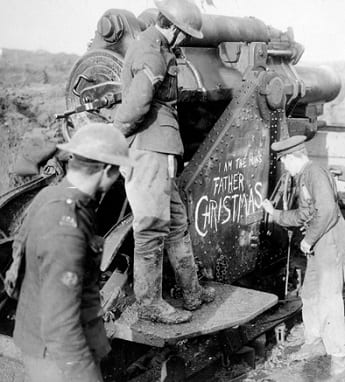Introduction - WW I Artillery Facts
When discussing the most important weapons of World War 1 perhaps what comes to mind are tanks, machine guns, poison gas, flame throwers, or maybe even airplanes. However the most extensively used, most devastating, and by far the most important was artillery. By far more than any other WW1 weapon artillery inflicted the most casualties. Thousands of different types of cannons (artillery) were deployed during WWI. These weapons ranged from relatively small mortars to gigantic naval guns and huge German long-range siege guns dubbed Paris Guns due to the fact several of them were used to bombard Paris France. On this page we list facts about World War I Artillery including information both kids and adults will find interesting; such as how they were used, what advances in artillery occurred during this war, and where some of the biggest artillery borages of the Great War took place.Click here for a great selection of Amazon.com books about WW1 artillery.
Interesting World War I Artillery Facts
- Over 14,000 different types of artillery were used during WW1; that is more than in WW2, the Korean War, and the Vietnam War combined.
- Many battles during World War One saw incredible artillery barrages involving thousands of cannons each firing numerous shells every minute. These barrages would often last for hours and some went on for many days or even weeks. Often they were preludes to infantry attacks or support for infantry attacks.
- One of the most intense artillery bombardments of WW1 began on July 18th 1917 as a prelude to the battle of Passchendaele (Third Ypres). The bombardment of German positions by the British lasted for about two weeks. In all approximately 4.5 million shells were launched from around 3,000 cannons prior to and along with the infantry attack which began on July 31st (1917).
- The use of Calvary charges in battle was common place prior to and at the start of World War One; however advances in artillery design along with the invention of machine guns put an end to this as charging horsemen would be easily cut down by these weapons.
- Artillery was used to shoot shells containing another deadly WW1 weapon; poison gas.
- During WW1 heavy artillery mounted on railroad cars were utilized. This enabled the weapons to be transported quickly to where needed.
- During World War 1 many advances in the development of artillery were made enabling bombardment from a further distance with more explosive power.
- One important improvement during World War 1, made by the British, was the invention of the No. 106 fuze. This fuse was designed to detonate a shell instantaneously upon it's touching any object. This would prevent shells from getting lodged in mud and then detonating which decreased their effectiveness. The No. 106 fuze would explode the shell immediately upon contact with the ground or other objects on the battlefield.
- Howitzers and mortars were used extensively during the Great War. Unlike other cannons that were fired directly at targets these cannons fire a shell with a high curving trajectory. The shells would be fired towards enemy positions with the hope that they would hit a target or land in a trench.
